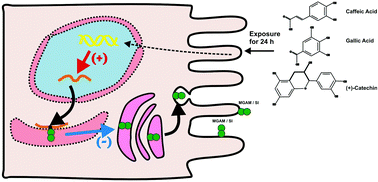Phenolic compounds increase the transcription of mouse intestinal maltase-glucoamylase and sucrase-isomaltase
Abstract
Diverse natural phenolic compounds show inhibition activity of intestinal α-glucosidases, which may constitute the molecular basis for their ability to control systemic glycemia. Additionally, phenolics can modify mRNA expression for proteins involved in nutritional, metabolic or immune processes. To explore the possibility that phenolics can regulate the mRNA expression, enzymatic activity, and protein synthesis/processing of intestinal Maltase-Glucoamylase (MGAM) and Sucrase-Isomaltase (SI), small intestinal explants from Balb/c mice were cultured for 24 h in the presence or absence of gallic acid, caffeic acid, and (+)-catechin at 0.1, 0.5, and 1 mM. We measured the levels of MGAM and SI mRNA expression by qRT-PCR, maltase and sucrase activities by a standard colorimetric method and the molecular size distribution of MGAM and SI proteins by western blotting. mRNA expression for MGAM was induced by the three phenolic compounds at 0.1 mM. mRNA expression for SI was induced by caffeic and gallic acids, but not by (+)-catechin. Caffeic acid was the most effective inducer of mRNA expression of these enzymes. Total maltase and sucrase activities were not affected by treatment with phenolics. The proportion of high molecular size forms of MGAM was significantly increased by two of the three phenolic compounds, but little effect was observed on SI proteins. Thus, changes in the protein synthesis/processing, affecting the proportions of the different molecular forms of MGAM, may account for the lack of correlation between mRNA expression and enzymatic activity.



 Please wait while we load your content...
Please wait while we load your content...